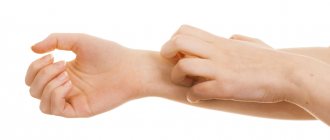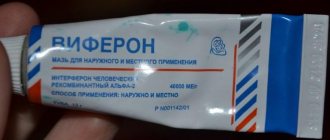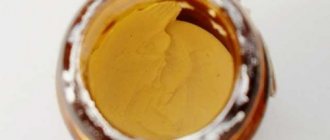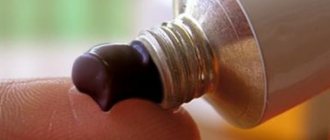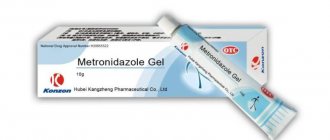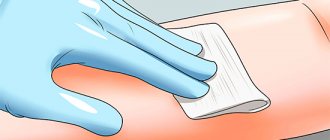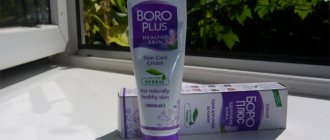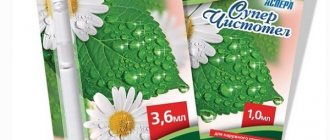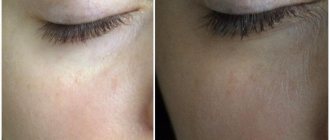Clotrimazole - description
Clotrimazole is an antimycotic (antifungal) ointment for local use in dermatology and gynecology. The product is available in different packages - 10-50 g. Among the companies producing it are Akrikhin (producing the drug Clotrimazole-Akri), Teva, ETS Pharma, GlaxoSmithKline, Pharmtechnologies and others.
How much the drug costs will depend on the manufacturer. Russian drugs are sold at a price of 20-70 rubles, among Polish, Indian, German drugs the cost is higher - 100-250 rubles.
The active component of the composition is clotrimazole in an amount of 10 mg.
Ointment (cream) can only be used externally. It is white with a yellowish tint, thick, but not greasy. The smell of the drug is specific. As additional components, the ointment includes:
- wax;
- polysorbate;
- monoglycerides;
- cetyl alcohol;
- water;
- Castor oil;
- glycerol
Clotrimazole is not only produced in ointment form. There are other forms on sale, for example, 1% alcohol solution, 1% gel. A vaginal form is also available - tablets for local use, which are convenient for use for gynecological diseases in women.
Features of application
Due to low toxicity and poor absorption into the bloodstream, Clotrimazole can be used during pregnancy. Laboratory studies have confirmed the absence of negative effects of the active component of the drug on the fetus and the body of the expectant mother. But before starting such therapy, you should definitely visit a gynecologist, since treating candidiasis with Clotrimazole in the first trimester is prohibited for pregnant women. The medicine is safe only in the second and third trimester. The use of the ointment is contraindicated for people suffering from allergies, as well as those who are intolerant to the components of the drug.
With the simultaneous use of Clotrimazole and nystatin antibiotics, the therapeutic effect of the latter is reduced. The drug is usually well tolerated, but during therapy discomfort may occur, manifested by:
- itching;
- burning;
- swelling;
- allergic rashes;
- hyperemia.
If such symptoms appear, you should stop treatment and notify your doctor. The doctor will adjust the therapy and, if necessary, prescribe a substitute.
Effect of the drug
Clotrimazole has a wide spectrum of action; it is effective against a large number of types of fungi. The antimycotic effect of clotrimazole, which is an imidazole derivative, is due to disruption of the most important processes in the fungal cell. The active substance negatively affects the synthesis of ergosterol, a component of cell membranes. As a result, the permeability of the membranes becomes higher, which provokes lysis and death of the cell.
The drug has a fungicidal and fungistatic effect depending on the amount of the substance applied.
Clotrimazole also acts by one more mechanism, which only increases its effectiveness. When interacting with cell enzymes, the substance causes an increase in the concentration of hydrogen peroxide. The level of the latter becomes toxic, fungal particles are destroyed.
In the form of an ointment, Clotrimazole helps against diseases caused by the following mycoses:
- dermatophytes;
- mold fungi;
- yeast fungi - candida and others;
- fungus that causes tinea versicolor - Malazessia furfur;
- mycosporum;
- dermatophyton;
- trichophyton;
- Cryptococcus;
- dimorphic fungi.
The drug also helps against the causative agent of erythrasma - corynebacterium, which is not a mycotic, but a bacterial cell. As an antimicrobial agent, Clotrimazole can be used against staphylococci and streptococci, Trichomonas, and a number of gram-negative bacteria.
WE RECOMMEND THE ARTICLE!
Sebozol helps solve the problem of infectious and fungal infections of the scalp. Read more >>
The product does not have a systemic effect, its penetrating ability is low. During treatment, clotrimazole is poorly absorbed through the skin and mucous membranes, but can accumulate in the stratum corneum of the nails. Clotrimazole is almost not detected in the dermis and subcutaneous tissue.
What kind of medicine is this
Clotrimazole is an antifungal drug that is equally often used by women and men for mycoses.
The medicine has a wide spectrum of action, therefore Clotrimazole is treated in:
- dentistry;
- dermatology;
- gynecology;
- urology.
The medicine is effective against staphylococci, streptococci, trichomonas, corynebacteria that cause erythrasma, and vaginal gardnerella. The active component of Clotrimazole is the substance of the same name. Its structure is a white crystalline powder that is insoluble in water and ether. But ethanol and chloroform completely dissolve the crystals.
The drug is produced in several forms. It is presented:
- ointment;
- gel;
- vaginal suppositories;
- tablets;
- powder;
- solution.
The ointment or gel is packaged in aluminum tubes of 20 g. They are placed in cardboard packs of 1 piece along with an annotation explaining what Clotrimazole ointment is used for. The tablets are placed on a blister of 6 pieces and packaged in paper boxes along with instructions. The most popular is 1% Clotrimazole ointment. It is available at the pharmacy without a prescription. Store the product for 3 years in a dark place at a temperature not exceeding 25*C. The medicine should not be frozen or used after the expiration date.
Clotrimazole is used as an external agent. If it comes into contact with the skin or mucous membranes, it is poorly absorbed and only 3-10% of the dose used enters the bloodstream. The main effect of the medicine is concentrated on the upper layers of the epidermis. The fungicidal effect of Clotrimazole is achieved by its ability to negatively influence pathogenic microorganisms. The active substance of the drug penetrates the microbial membrane and disrupts the structural integrity and functional ability of the bacterium.
Clotrimazole helps very well against Candida fungus. Under its influence, the reproductive properties of microorganisms slow down, their activity decreases, and internal processes that ensure the viability of microbes are disrupted. Depending on the concentration of the drug used, the antifungal effect of the drug varies. Low doses of ointment inhibit the vital activity of microbes, and high doses kill pathogenic microorganisms by destroying fungal membranes and have a disinfecting effect.
Upon entering the body, it is quickly transformed into safe metabolites by liver cells and excreted in the feces. With intravaginal administration, a high concentration is observed in vaginal discharge for 2-3 days.
Main indications
This remedy has a variety of indications related to different areas of medicine. In the form of an ointment, Clotrimazole is used for dermatitis caused by fungal pathogens and for mycotic diseases:
- stop;
- fingers and toes;
- open areas of skin;
- palms;
- skin folds;
- periungual ridges;
- interdigital spaces;
- nails
The drug is most active against dermatophytes and yeast fungi. With its help you can get rid of dermatomycosis, mycotic paronychia, canidomycosis, skin microsporia, trichophytosis and epidermophytosis. The medicine quickly heals fungal erosions, which most often appear in the spaces between the fingers in men and women. Clotrimazole ointment is also effective against fungi on the legs.
Due to its ability to act on bacteria, the ointment can be applied to skin with mycosis that has been affected by a secondary bacterial infection. This is usually observed with secondary pyoderma occurring in conjunction with mycosis. Externally, the ointment is used for the following pathologies:
- pityriasis versicolor and versicolor;
- Erythrasma is a chronic bacterial pseudomycosis.
In women, the drug can be used for thrush - vaginal candidiasis, and for vulvovaginal candidiasis. In complex therapy with systemic agents, Clotrimazole ointment helps women against trichomoniasis. In men, the drug is applied to the genitals for candidiasis balanitis, balanoposthitis.
For foot fungus
Clotrimazole treats not only fungal infections of the nails, but also the skin of the feet. Therapy takes up to 3 weeks. The patient is recommended to apply Tori ointment once a day. The ointment should be applied in a thin layer to previously washed and towel-dried feet. When applying the product, cover not only the damaged area, but also a small area of healthy skin, massage the surface with light movements until the ointment is absorbed. Even if the symptoms of the disease have disappeared, you should use the ointment for the entire course. Stopping treatment prematurely will cause a relapse because not all bacteria have died.
Clotrimazole ointment for men
Clotrimazole ointment is used for men to treat many diseases of the urogenital area. Main indications for use of the drug:
- urogenital candidiasis (thrush);
- dermatophytosis;
- fungal infections in the groin area;
- fungus of fingernails and toenails;
- pityriasis versicolor and ringworm.
The main advantage of Clotrimazole ointment is that it not only reduces the unpleasant symptoms of the disease, but also affects its causative agent - fungal microorganisms or pathogenic bacteria. If you have thrush, your partner should also undergo treatment at the same time as the man.
To treat urogenital candidiasis, you need to wash the affected areas of the skin well with a soap solution or a weak solution of potassium permanganate and dry with a towel. After this, apply a thin layer of Clotrimazole ointment and leave it until completely absorbed.
The duration of treatment with Clotrimazole depends on the type and severity of the disease in the man. For thrush, the product should be used twice a day for 20 days, for lichen, treatment lasts 15-25 days, for erythrasma - up to 30 days. To prevent relapse of the disease, Clotrimazole ointment should be used for another 2 weeks after the symptoms disappear.
Analogues of Clotrimazole ointment
The pharmacological market offers a large number of drugs that are similar in action to Clotrimazole, but differ in release form, price, and composition. Some may cause fewer side effects or work faster. The main analogues of Clotrimazole are:
- Candide. An antifungal medication that has a wide spectrum of action against fungal microorganisms. The main active substance of Candida, clotrimazole, is a form of the substance imidazole. Due to the fact that the drug damages the membranes of fungal cells, according to reviews, it is considered one of the best antifungal agents. The cost of the medicine is about 80 rubles.
- Kanizon. The drug has fungistatic and fungicidal effects, the manifestation of which depends on the doses of the drug used. The following groups of fungi are sensitive to the drug Kanizon: dermatophytes, moldy fungi, blastomycetes and dysmorphic fungi, actinomycetes. The active component inhibits the synthesis of molecules of the substance ergosterol, which is necessary for the formation of cell walls of pathogenic microorganisms. The price of the medicine is on average 75 rubles per package.
Other drugs are prescribed to treat fungal diseases. There are analogues of Clotrimazole:
- Candide;
- Kandibene;
- Kanesten;
- Kanizon;
- Amyclone;
- Antifungal;
- Lamisil.
All analogues of Clotrimazole ointment are divided into substitutes with the exact composition and other drugs with a similar effect based on antifungal agents (for example, bifonazole, terbinafine), combined external agents.
| Name | Active substance | Price, rubles |
| Clotrimazole | Clotrimazole cream 20 g | 73-190 |
| Candide 20 g | 280 | |
| Clotrimazole and betamethasone | Candide B 15g | 450 |
| Clotrimazole and betamethasone, gentamicin | Candiderm 15 g | 490 |
| Candiderm 15 g | 670 | |
| Akriderm GK 30 g | 650 | |
| Kanizon plus 15 g | 380 | |
| Terbinafine | Exiter 15 g | 220 |
| Lamisil 15 g | 450 | |
| Terbinafine 15 g | 63-180 | |
| Terbizil 15 g | 265 | |
| Bifonazole | Mycospor 15 g | 480 |
| Econazole | Ecodax 10 g | 165 |
| Miconazole | Mycozone 15 g | 128 |
| Ketoconazole | Nizoral 15 g | 460 |
| Mycozoral 15 g | 257 |
Clotrimazole ointment is intended for the treatment of fungal diseases of the skin and mucous membranes. It is used for thrush, pityriasis versicolor, trichomoniasis, and a combination of fungus and bacteria. The course of treatment is from 2 weeks.
- Ointment for ringworm: which one is suitable for children, for ringworm on...
What is the most effective ointment for ringworm. Which one is suitable for treating children, from pink or white, shingles and ringworm. What ointment for ringworm to use on the head. Is there one that is suitable for all types of lichen? How to apply Clotrimazole, Zinc, Terbinafine, Salicylic, Advantan, Levomekol, Yam ointment, Vishnevsky ointment, Triderm, Nizoral. - Tetracycline ointment: how to apply it correctly when…
Features of the use of Tetracycline ointment, important recommendations for applying the drug to children and adults. Instructions for use for eye diseases, what else helps. How does Tetracycline ointment work for allergies? Side effects and age restrictions. Analogues of the ointment and the cost of the drug in the pharmacy.
- Acyclovir ointment: what is it used for, how to use it correctly...
Instructions for use of Acyclovir ointment. Composition and indications for use. How to apply correctly, how long you can use it. How to use it for colds, herpes, acne. Contraindications for use and possible complications. Cost of Acyclovir ointment, its analogues.
- Oxolinic ointment: how to use for a runny nose, colds...
What does cheap Oxolinic ointment help with? How to use it correctly for a runny nose or cold. Is it possible for children under one year of age, during pregnancy and breastfeeding? Contraindications to Oxolinic ointment. Why does it turn purple?
- Ointment for wound healing: which one is suitable for open...
How is ointment used to heal wounds? The best ointment for purulent and open wounds, for skin regeneration. Which one should you choose for children during pregnancy? What to use for cracks. Effective ointments with antibiotics. Which is better - cream or gel?
- Scar ointment: which one is suitable for healing...
What is the most effective ointment for scars that will help better with scars. Which drug promotes resorption and healing - Heparin ointment, Ichthyol ointment, Anti scar, Zinc ointment, Solcoseryl and others.
Side effects, contraindications
The medicine is usually well tolerated. Due to the lack of systemic absorption, only local side effects are possible, which manifest themselves in the form of itching, red spots, rash, tingling, burning. Most often, burning and itching are observed with intravaginal use. Usually, discontinuation of therapy is not required, unpleasant phenomena quickly pass. In rare cases, a local form of urticaria may develop. Also rarely observed among unpleasant reactions are:
- severe irritation;
- blisters;
- peeling.
When treating candidiasis, women sometimes experience increased urination. In case of overdose during intravaginal application, there is a risk of abdominal pain, diarrhea, and headaches (in isolated cases).
During pregnancy in the 1st trimester, it is better not to use any medications, only if absolutely necessary. But according to indications, treatment in pregnant women is possible, since in experiments clotrimazole did not have a negative effect on the fetus. During lactation, it is prohibited to smear the skin of the mammary gland; therapy on other parts of the body is permitted. Children under 2 years of age are not treated with ointment, as is the case with end-stage liver diseases. It makes no sense to treat herpes with this remedy - the ointment does not help with viral pathologies.
Pregnancy and lactation
No toxic effects of the drug on the fetus have been identified; use is relatively safe at all stages of pregnancy. Therapeutic doses of the drug do not affect fetal development. It is recommended to use Clotrimazole for the prevention of fungal infections for women in the first trimester of pregnancy who have an unfavorable permanent environment (for example, if a girl works in a kindergarten or medical institution). Use during breastfeeding is not prohibited if the cream does not come into contact with the mammary glands.
Instructions for use
The medicine can be used exclusively externally and intravaginally. For mycotic lesions of the feet and open skin areas, the procedure for treatment is as follows:
- wash or otherwise clean the skin, degrease it (only products with a neutral pH level can be used);
- dry the area thoroughly;
- squeeze out the ointment from the tube in a small amount;
- lubricate the skin with a thin layer of Clotrimazole;
- repeat therapy 2-3 times a day;
- Children over 2 years of age are shown similar treatment; the dosage and order of therapy do not differ from adults.
A single dosage should not exceed 5 cm of a column of ointment; this norm is indicated for an area the size of the palm of an adult. The product must be used regularly; skipping therapy helps reduce the infection’s reactivity to the active component. Treatment is carried out until symptoms disappear completely, plus 3-5 days; for foot fungus, an additional 14 days of treatment is required. Typically the course lasts 10-28 days depending on the type of infection. For a combination of bacterial and fungal infections, the course is 1 month. Erythrasma usually goes away in 2-3 weeks; pityriasis versicolor is treated for 1-3 weeks.
On the recommendation of a doctor, the ointment can be used to treat oral thrush (although a solution is usually used for this purpose). Treatments are done 1-2 times a day, the maximum course is 7 days. The ointment is administered into the vagina using a tampon or an applicator in the same doses once a day at night. The course for thrush and trichomoniasis is 5-6 days.
What is Clotrimazole cream
An antifungal drug in the form of an ointment is intended for external and vaginal use. The aluminum tube with the medication has an outer packaging - a cardboard box. The drug comes with instructions for using Clotrimazole. You can buy this medicine at a pharmacy without a doctor's prescription; it can be stored for two years in a dry place without sunlight.
- Candide - instructions for use, release form, indications, side effects, analogues and price
- Kanizon - instructions for use of ointment, cream and solution, indications, composition, side effects, analogues and price
- The best ointments for nail fungus on the toes and hands
When Clotrimazole ointment is prescribed, the instructions for use inform the consumer that the ointment must be applied in small portions (dosage is 5 millimeters) onto a clean, dry surface and rubbed in with light circular movements. The duration and frequency of use of the cream is strictly individual for each person, the type of lesion, and is determined when the drug is prescribed by a doctor. According to the annotation, the ointment can be applied to areas of inflammation:
- skin of the whole body;
- mucous membranes of the oral cavity, genital organs (excludes the mucous membrane of the eyes).
https://www.youtube.com/watch?v=Vn67AoQgxmg
The drug is made on the basis of petroleum jelly (paraffin). Clotrimazole contains excipients:
- propylene glycol;
- polyethylene oxide;
- methyl parahydroxybenzoate or methylparaben (nipagin).
The active substance of the drug comes from the imidazole group. The mechanism of the therapeutic effect of the substance is based on the fact that it disrupts the synthesis of ergosterol in fungal cells. This leads to disruption of the structure and damage to cell membranes. Additionally, the substance interacts with fungal enzymes, promotes the formation and accumulation of hydrogen peroxide in cells, which destroys cells.
The properties of the drug to have a destructive effect on pathogens of fungal and infectious diseases are used to treat various diseases. It suppresses the action of pathogens:
- mycoses (yeast, mold, dermatophytes);
- coccal infections (streptococci, staphylococci);
- trichomonas infections.
According to the instructions, there are indications for the use of Clotrimazole:
- candidal balanitis and vulvitis;
- stomatitis;
- trichophytosis (ringworm);
- paronychia (inflammation of the periungual fold);
- trichomoniasis;
- pityriasis (pityriasis rosea);
- psoriasis;
- erythema;
- erythrasma (bacterial infection of the skin in folds);
- inflamed hemorrhoids.
The drug should be used with caution during lactation. The instructions for Clotrimazole ointment contain warnings - when using the cream for the first time, it is recommended to apply it to a small area and see the reaction. When used, possible side effects of Clotrimazole ointment:
- at the sites of application - irritation, allergic reaction (peeling, redness of the skin, hives, tingling, itching, burning, blistering);
- headache, indigestion:
- frequent urination - in the treatment of genital candidiasis.
If there are indications for the use of the drug and hypersensitivity to the active substance, the drug should not be used. There are contraindications for Clotrimazole:
- during pregnancy in the first months;
- when drinking alcohol and antibiotics;
- child under 12 years old;
- liver diseases;
- during menstruation in case of vaginal administration.
Clotrimazole ointment helps against fungus (thrush, lichen versicolor, lesions on the foot, between the toes, in the perineum). Directions for use: Apply to clean and dry skin 2-3 times a day. The course of treatment is 2-6 weeks. Should not be used for other purposes - for example, for hemorrhoids.
Women are prescribed Clotrimazole ointment for the following indications:
- candidiasis (thrush) in the area of the labia, vagina;
- fungal infections in the perineal area caused by microorganisms sensitive to the drug (dermatophytes, molds, yeasts);
- trichomoniasis (complex treatment, Clotrimazole alone does not help);
- prevention of thrush in chronic cases (after internal administration of drugs);
- prevention of infection before childbirth.
In addition to gynecology, the medication is used to treat foot fungus, interdigital spaces, and skin. For toenails, Clotrimazole is used exclusively after removal of the nail plate or its maximum filing. The drug is ineffective for fungal diseases of the scalp.
When nails are affected by fungus, applying an alcohol solution of Clotrimazole will be more effective than applying a cream or ointment. After the emergence of new antifungal agents (Lamisil, Mycospor), dermatologists extremely rarely prescribe this drug; they are mostly treated independently for a long time and often unsuccessfully.
Use in men
For men, it is recommended to apply the cream when the glans penis is inflamed. To do this, after hygiene procedures (soap with a neutral reaction is used - pH up to 7), the foreskin is treated with a disinfectant solution (Furacilin, diluted hydrogen peroxide). Then you need to thoroughly dry the organ, followed by a careful application of a pea-sized column of the drug. It is rubbed a little into the skin and left until absorbed.
Indications for children
For children under 2 years of age, Clotrimazole is prohibited; at older ages, only a doctor prescribes it and monitors the treatment process. This remedy is used for pityriasis versicolor (varicolored) and fungal infections complicated by rashes.
It is important to consider that there is no exact data on the safety of the drug up to 12 years. Therefore, it is necessary that the course of application does not exceed 2 weeks, and the application area is no larger than the child’s palm. Lubrication under a bandage or diaper is not recommended.
Tinea versicolor
During pregnancy, the medication is considered contraindicated in the first trimester. During this period, the formation of internal organs and the brain of the fetus occurs. Therefore, only those drugs are allowed for which clinical studies have been conducted and proven to have no effect on the child. There are no such data for Clotrimazole.
Its use is allowed only from 4 months, but as prescribed and under the supervision of a gynecologist. During lactation, it can be applied to the skin of the perineum and legs, but it is forbidden to lubricate the mammary glands.
Depending on the disease, different treatment regimens are used (see table).
| Diagnosis | How to apply | How many days to use |
| Fungal diseases on the body, skin folds | After washing with neutral soap and drying, 2 times a day with gentle rubbing | Month |
| Tinea versicolor | On the area of peeling 3 times a day | 2 weeks |
| Fungus on the foot | Wash and dry the skin, lubricate 2 times a day | After complete disappearance of symptoms, another 2 weeks |
| Nail damage | On the filed nail plate 3-4 times a day | 2.5-3 months |
| Fungus with pustular rash | Treatment with an antiseptic (for example, Chlorhexidine), and after an hour Clotrimazole 2 times a day | 10-14 days |
| Thrush in women | After washing with neutral soap (preferably Lactacid 5.5 or analogues) and drying, apply a thin layer of ointment at night; simultaneous use of suppositories or vaginal 2% cream is recommended | 10 days followed by smear control |
special instructions
To increase the effectiveness of treatment and avoid adverse consequences, it is necessary:
- use the drug for genital fungal infections, trichomonas in both partners;
- Do not use for women during menstruation;
- refuse to introduce tampons, douching, or suppositories with a contraceptive effect (for example, Pharmatex);
- wash your hands after application;
- avoid contact with eyes;
- when using a condom and Clotrimazole ointment, cream, suppositories, the strength of the latex decreases, therefore the reliability of contraception decreases, this effect continues for another 5 days after the end of treatment.
Contraindications
Clotrimazole is contraindicated in the first 3 months of pregnancy, up to 2 years and in case of individual intolerance. Use with caution during pregnancy (from the 2nd trimester) and in nursing mothers, with severe liver diseases. In the latter case, with a course of treatment of 2 weeks or more, monitoring of tests (liver enzymes) is necessary.
Self-medication with Clotrimazole is strictly prohibited for:
- known allergies to antifungal drugs;
- a history of a sexually transmitted disease (including in a partner);
- fever;
- pain in the lower abdomen, in the lumbar region;
- frequent and painful urination;
- discharge from the genitals with an unpleasant odor, mixed with blood or pus;
- bleeding;
- vomiting, diarrhea;
- ulcers on the mucous membrane.
Side effects
When used correctly, the drug is usually well tolerated, but with increased sensitivity there are:
- itching,
- peeling,
- irritation,
- rashes,
- blisters,
- redness,
- burning,
- tingling,
- pressure reduction,
- fainting state,
- dyspnea.
There are no known cases of overdose due to the use of large doses or long-term treatment. However, self-medication is not recommended. If after 2 weeks of use there is no improvement, consultation with a dermatologist or gynecologist for women and a urologist for men is necessary.
Consultation with a gynecologist
If the drug is accidentally taken orally, then if nausea and vomiting develop, gastric lavage is necessary. Due to the relatively low concentration, in most cases the poisoning is mild.
Concomitant treatment with drugs that contain:
- Natamycin (Pimafucin, Pimafucort);
- Nystatin (Makmiror, Nystatin suppositories, Polygynax).
All of them reduce the activity of Clotrimazole.
For fungal diseases of the skin, nails, and vaginal candidiasis (thrush), drug therapy with the antibacterial ointment Clotrimazole is prescribed. The drug has a strong antifungal effect on pathogens of erythrasma, fungal psoriasis and other common mycotic diseases. The doctor can prescribe an ointment at the first symptoms of infection, to prevent mycosis in the layers of the skin and on the vaginal mucosa.
The drug inhibits the growth, development and division of fungal cells. In addition, the drug is widely used for genital tract infections (for example, vaginal mycosis of the vaginal lining). To treat candidiasis, ointment is prescribed to both sexual partners. In this case, it is recommended to apply the cream both before and immediately after sexual intercourse.
When to use?
"Clotrimazole" is used to treat fungal pathologies of the skin and mucous membranes. It is effective against several types of microorganisms:
- molds and yeasts;
- dermatophytes;
- pathogens of lichen and erythrasma.
The ointment has an antimicrobial effect and helps in the fight against cocci, gardnerella, trichomonas and other gram-positive and gram-negative bacteria.
From this article you will learn everything about such a disease as erythrasma.
Indications for using the cream are the following diseases:
- mycoses of the mucous membrane and skin caused by the above microorganisms (including vaginal candidiasis);
- pityriasis versicolor and multicolored forms of lichen;
- erythrasma.
Among the contraindications to the use of ointment, the instructions mention:
- individual intolerance to the components included in the medication;
- menstruation (in the treatment of vaginal forms of fungal diseases);
- lactation;
- 1st trimester of pregnancy.
"Clotrimazole" is suitable for treating babies from the first months of life and has no age restrictions.
Important! If you are pregnant, consult your doctor before using the cream, since the effect of Clotrimazole on the condition of the fetus has not been fully studied.
Clotrimazole for dermatitis
The drug will be effective in treating dermatitis if the disease is caused by a fungus. In other cases, the medication is powerless.
The product is not effective against the following forms of skin lesions:
- contact;
- atopic;
- allergic.
The drug is effective against seborrhea. This is a fungal infection of the scalp, manifested by peeling and itching. The disease must be treated, since scratches can become infected, and this will lead to complications. The product is applied to the areas affected by the fungus. The course of treatment is discussed with the doctor, since the nature of the course of the disease in each patient is individual.
Varieties and composition
In addition to Clotrimazole ointment, from which the medication helps a larger number of patients, the following dosage forms are produced:
- solution;
- vaginal suppositories (suppositories);
- granules;
- powder for external use;
- gel;
- vaginal tablets;
- cream;
- spray.
The active element of Clotrimazole is the substance of the same name, the content of which in the gel, ointment, cream and solution is 1% of the total volume. The suppositories contain 100 mg of the active ingredient. Tablets may contain 0.1, 0.2 or 0.5 g of clotrimazole. The box with the drug contains instructions for use.
Excipients, depending on the form of release of the drug, can be: propylene glycol, ethyl alcohol, sage ether, octyldodecanol, polysorbate, methylparaben, nipagin, semi-synthetic glycerides, adipic acid, sodium lauryl sulfate and other components.
Features of using Clotrimazole
Use ointment and other dosage forms of antifungal agents with extreme caution during pregnancy and lactation:
- Despite the insignificant penetration of the antifungal substance into the systemic bloodstream and through the placental barrier, Clotrimazole is not recommended for use in the first trimester of pregnancy. More detailed information about the treatment of thrush during pregnancy is presented on this page.
- Clotrimazole for thrush in women is used during lactation, but the use of an antifungal drug must be discussed with a doctor. The doctor sets the dose and duration of therapy individually in each case. It is forbidden to apply cream to the mammary gland area.
If treatment of a fungal infection coincides with the beginning of the menstrual cycle, the ointment continues to be used despite the discharge. To achieve a clinical effect, the course of therapy is extended for several days.
Antifungal drugs often cause an allergic reaction. This should be remembered by patients with a history of allergies. You can suspect an allergy to an antimycotic agent based on the following signs:
- itching, burning in the area of application;
- hyperemia of the skin and mucous membranes;
- pain, dryness in the intimate area;
- rashes in the form of hives or blisters.
If taking sorbents and antihistamines does not eliminate the allergy, further use of the drug should be agreed upon with the attending physician.
Treatment of a fungal infection in most cases is a lengthy process: complete death of the fungus occurs only when there is sufficient accumulation of pyridoxine in its cells.
The use of an antifungal agent for thrush in women in the first days of treatment may cause increased vaginal discharge. This is due to the massive death of the fungus as a result of the action of the drug. This condition usually disappears after 3 days. If no improvement is observed within three days, you should consult a doctor.
